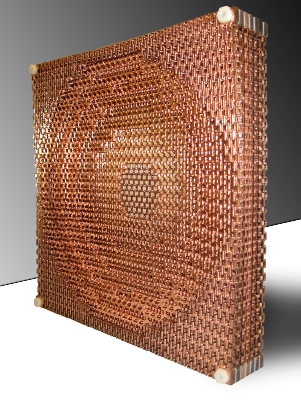Nov 16 2012
In many respects, metamaterials are supernatural. These manmade materials, with their intricately designed structures, bend electromagnetic waves in ways that are impossible for materials found in nature.
 The orientation of 4,000 S-shaped units forms a metamaterial lens that focuses radio waves with extreme precision, and very little energy lost. (Photo: Dylan Erb)
The orientation of 4,000 S-shaped units forms a metamaterial lens that focuses radio waves with extreme precision, and very little energy lost. (Photo: Dylan Erb)
Scientists are investigating metamaterials for their potential to engineer invisibility cloaks — materials that refract light to hide an object in plain sight — and “super lenses,” which focus light beyond the range of optical microscopes to image objects at nanoscale detail.
Researchers at MIT have now fabricated a three-dimensional, lightweight metamaterial lens that focuses radio waves with extreme precision. The concave lens exhibits a property called negative refraction, bending electromagnetic waves — in this case, radio waves — in exactly the opposite sense from which a normal concave lens would work.
Concave lenses typically radiate radio waves like spokes from a wheel. In this new metamaterial lens, however, radio waves converge, focusing on a single, precise point — a property impossible to replicate in natural materials.
For Isaac Ehrenberg, an MIT graduate student in mechanical engineering, the device evokes an image from the movie “Star Wars”: the Death Star, a space station that shoots laser beams from a concave dish, the lasers converging to a point to destroy nearby planets. While the researchers’ fabricated lens won’t be blasting any planetary bodies in the near future, Ehrenberg says there are other potential applications for the device, such as molecular and deep-space imaging.
“There’s no solid block of any material in the periodic table which will generate this effect,” Ehrenberg says. “This device refracts radio waves like no other material found in nature.”
Ehrenberg published the results of his research in the Journal of Applied Physics. His co-authors on the paper are Sanjay Sarma, the Fred Fort Flowers and Daniel Fort Flowers Professor of Mechanical Engineering at MIT, and Bae-Ian Wu, a researcher at the Air Force Research Laboratory.
Shaping a cell
A metamaterial’s extraordinary properties are determined largely by its structure — similar to how a diamond’s crystals impart strength. A material can refract light differently depending on the shape of individual units within a material, and the arrangement of those units as a whole.
Prior to this recent paper, Wu and others have studied how certain shapes of metamaterials can affect the propagation of electromagnetic waves. The team came up with a blocky, S-shaped “unit cell” whose shape refracts radio waves in particular directions. Ehrenberg used the unit shape as the basis for his concave lens, creating the rough shape from more than 4,000 unit cells, each only a few millimeters wide.
To fabricate his design, Ehrenberg utilized 3-D printing, building a lens layer by intricate layer from a polymer solution. He then washed away any residue with a high-pressure water jet and coated each layer with a fine mist of copper to give the lens a conductive surface.
To test the lens, the researchers placed the device between two radio antennae and measured the energy transmitted through it. Ehrenberg found that most of the energy was able to travel through the lens, with very little lost within the metamaterial — a significant improvement in energy efficiency when compared with past negative-refraction designs. The team also found that radio waves converged in front of the lens at a very specific point, creating a tight, focused beam.
Imaging space and beyond
Sarma says the combination of the device’s “low loss” and tight focus is a promising step toward engineering practical metamaterial lenses.
“There are a lot of phenomena in the world that you can demonstrate, but whether you can achieve it at scale is the issue,” Sarma says. “We’ve taken the negative refraction concept from the realm of proof-of-concept to the realm of practicality.”
The device, which weighs less than a pound, may be used to focus radio waves precisely on molecules to create high-resolution images — images that are currently produced using bulky, heavy and expensive lenses. Ehrenberg says that such a lightweight device could also be mounted on satellites to image stars and other celestial bodies in space, “where you don’t want to bring up a hefty lens.”
Cheng Sun, an assistant professor of mechanical engineering at Northwestern University, says the metamaterial design is a promising demonstration that may lead to stronger, faster telecommunications.
“The low-loss design can be considered a significant step forward toward practical applications at microwave or radio-frequencies ranges,” Sun says.
Beyond the lens’ applications, Ehrenberg says its fabrication is simple and easily replicated, allowing other scientists to investigate 3-D metamaterial designs.
“You can really fully explore the space of metamaterials,” Ehrenberg says. “There’s a whole other dimension that now people will be able to look into.”